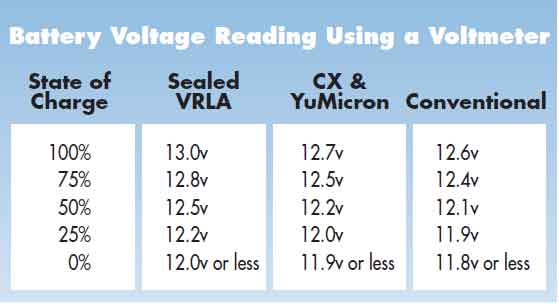Translate This Page
Updated 09/03/24
Please note.
We do not sell batteries. This is independent advise based on the science and our long experience.
Any Varta LFD batteries now being sold will be old stock.
The LFD90 has been superseded by the LED95 EFB https://www.alpha-batteries.co.uk/12v-90ah-varta-lfd-90-professional-leisure-battery-930090080/
However, these batteries, as with all "E"nhanced "F"looded "B"atteries are technically of wet lead construction with a recycle rating of around 200 and should be charged in the same way as any wet lead battery. In the case of a most Schaudt products, this is the Blei-Saure setting.
They MUST be vented to the outside.
Due to health & safety concerns, we no longer recommend ANY wet lead (lead acid) battery for habitation use
unless in a sealed compartment and vented to the outside.
Our battery of choice for habitation use in a motorhome or touring caravan fitted with any model of Schaudt electroblock
is the Gel construction Exide ES900 which has a recycle rating of 800 and is safe for use inside the living area.
https://www.alpha-batteries.co.uk/80-ah-exide-g80-gel-deep-cycle-leisure-battery/
Take two batteries, one a big name high technology battery and the other a budget with conventional technology.
The big name battery costs £105 yet has 3 times longer life than the £99 'Budget' battery, so you can see which is the more cost effective.
But if I also demonstrated how the big name battery not only lasted more than 3 times longer, but also, charged twice as fast, didn't self discharge, didn't gas or lose any fluid, was more efficient on Solar, delivered 70% better electrical flow, etc. you can see how different batteries have become, for not very much difference in cost?
Technology has advanced the best Batteries so much, that for similar cost one high technology battery can be more than 3 times better than the next old fashioned construction battery, without paying anything other than 'Budget' battery prices.
Alpha Batteries is a Battery retailer that has created a really good website and provides more information than any other allowing you to do your own Battery comparisons.
Unlike other sites, they list cycle life and ideal charging voltages, etc. One typical battery that is a good example of how very different two batteries in the same price bracket can be, is this : Platinum LB6110l It is rated at a very poor 70 cycles yet costs £105.
Versus one of the best in the Class, using state of the art technology, the Exide ES900 with a recycle rating of 800 at around £175, it just doesn't make sense to buy anything other than a quality big name battery.
We started this page with the intention of trying to highlight that the 'Budgets' were not the low cost option they seem. Especially when they can cause charger and alternator destruction when they fail.
Around 70% of all the Motorhome and Caravan charger failures we see are due batteries that are past EOL (End Of Life), damaged, of the wrong type or a larger capacity that the maximum permissible.
We began looking for a battery that wasn't expensive, had decent lifetime and was also kind to chargers.
Powerframe technology with batteries like the Varta LFD90 (now obsolete) and the Bosch L5 became our 'Best Budget Buy' recommendation back in 2013 and since then it's reputation has become legendary but so much has happened since then.
During the last few years the Leisure battery industry lost it's way by diverging off into over marketed, short life AGM's (Absorbed Glass Mat), leaving the Powerframe Bosch L5/Varta LFD 90 to have the up to £150 sector to itself. With the industries realization that AGM's were not delivering the promised life time when used as motorhome Leisure batteries, there was a massive flurry of activity leading to a whole string of exceptional EFB Leisure batteries entering the market.
These batteries use Enhanced Flooded Battery (EFB) technology, it is the technology of the moment, replacing AGM batteries in many of the big name car manufacturers vehicles like Audi, BMW, VW, Mercedes, Seat, etc.
Even Land Rover are searching for alternatives to poor performing AGM's.
These new advances and investment by the big manufacturers means the 'Best Budget Buy' Varta LFD/Bosch L range is getting really serious competition. While still an outstanding battery in almost every way it's no longer the only choice in that price range.
For example, the Yuasa L36-EFB makes the Powerframe batteries look quite poor but still has a recycle rating of just 200 and should be charged with the Wet lead profile and IUoU curve with the electroblock set to Blei-seure.
PLEASE NOTE : The YUASA L36-100 is no where near as capable as the L36-EFB. The technology of the moment is Enhanced Flooded Batteries, the '100' version is a conventional battery.
Thanks to the high Carbon technology inside the Yuasa L36-EFB battery it is also higher capacity, 100Ah versus the old Varta LFD's 90Ah. Yuasa claim a charging rate that is 1.7 times faster, which proves this has some major efficiency improvements over an old fashioned, conventional battery range.
According to the Yuasa L36-EFB test data results to BS EN 50342, it has laboratory data to back up it's 230 cycle capability, even though Yuasa understate it's capability at just 200 cycles. While it's resting voltage isn't as high as the old Varta LFD90 at 12.97v, it's still higher than a conventional batteries at about 12.8v, with a 50% discharged SOC of about 12.3v.
So it falls about half way between the VRLA column and the Yuasa YX Micron column in the battery SOC chart.
Continuing updates. watch this space.
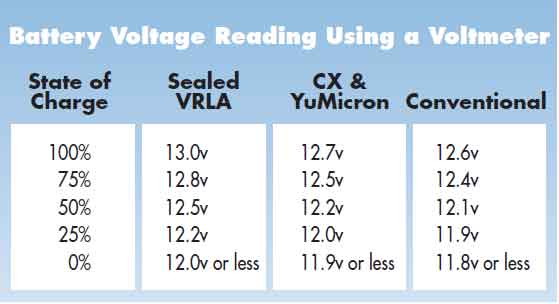
The Yuasa L36-EFB at around £120 is our new budget best buy. While gassing is low for this type of wet Acid battery, almost to Gel standards, Yuasa say a vent pipe to the outside is necessary.
Most of the technology comments below also apply to the Yuasa EFB which has achieved 230 cycles in testing versus the Bosch L series and the old Varta LFD at 200 cycles.
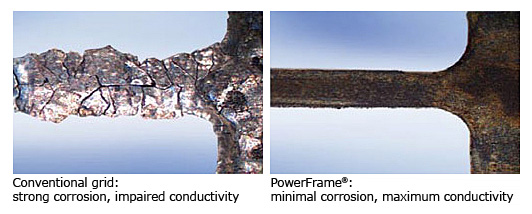
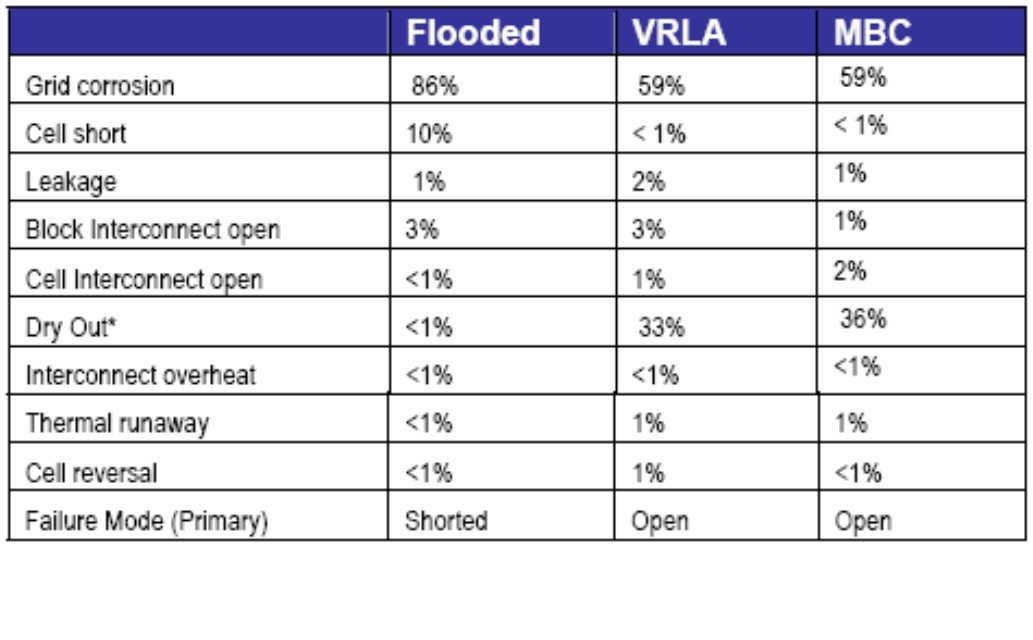


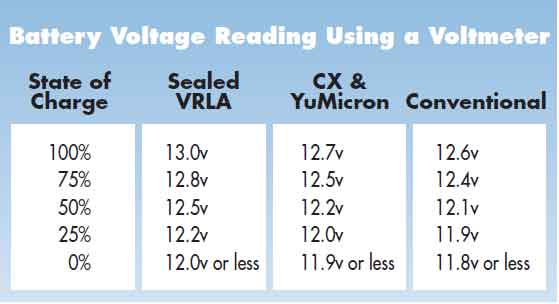


|
bosch brochure 2014.pdf Size : 3717.21 Kb Type : pdf |

The resistance varies with the state of charge, not just internal degradation, which can skew the results. While they sometimes use the voltage to ascertain a batteries state of charge, some are unable to cater for the different voltage ranges of the different battery technologies.
Further to that, one issue may reduce the resistance, like Antimony poisoning, while Internal Corrosion may increase it balancing each other out and showing a 'healthy' battery when it isn't.
Batteries degrade for a number of reasons and it is possible to fully charge a battery that then delivers enough power to start a Fiat 3.0, but will slowly lose charge over days.
So while the Starter battery might get a 'Pass' of 550 out of 650 'cranking amps' when tested straight after a recharge, it may be down to half that after just a week.
Such a battery is no use to many motorhomes that stand idle for long periods, but be perfectly adequate for a Car/Van that is used every day.
Conversely a battery could be down to 70% of it's rated capacity yet hold it's charge for months.
The third type of battery tester that adds a 'small 'load' just prior to the resistance check, can be more accurate, but not infallible when used on Motorhome/Caravan batteries..
All the test units check primarily for the 'instant' power a car/Van/truck Starter battery can deliver, as this is the most important factor for the vast majority of vehicles that are used every day.
